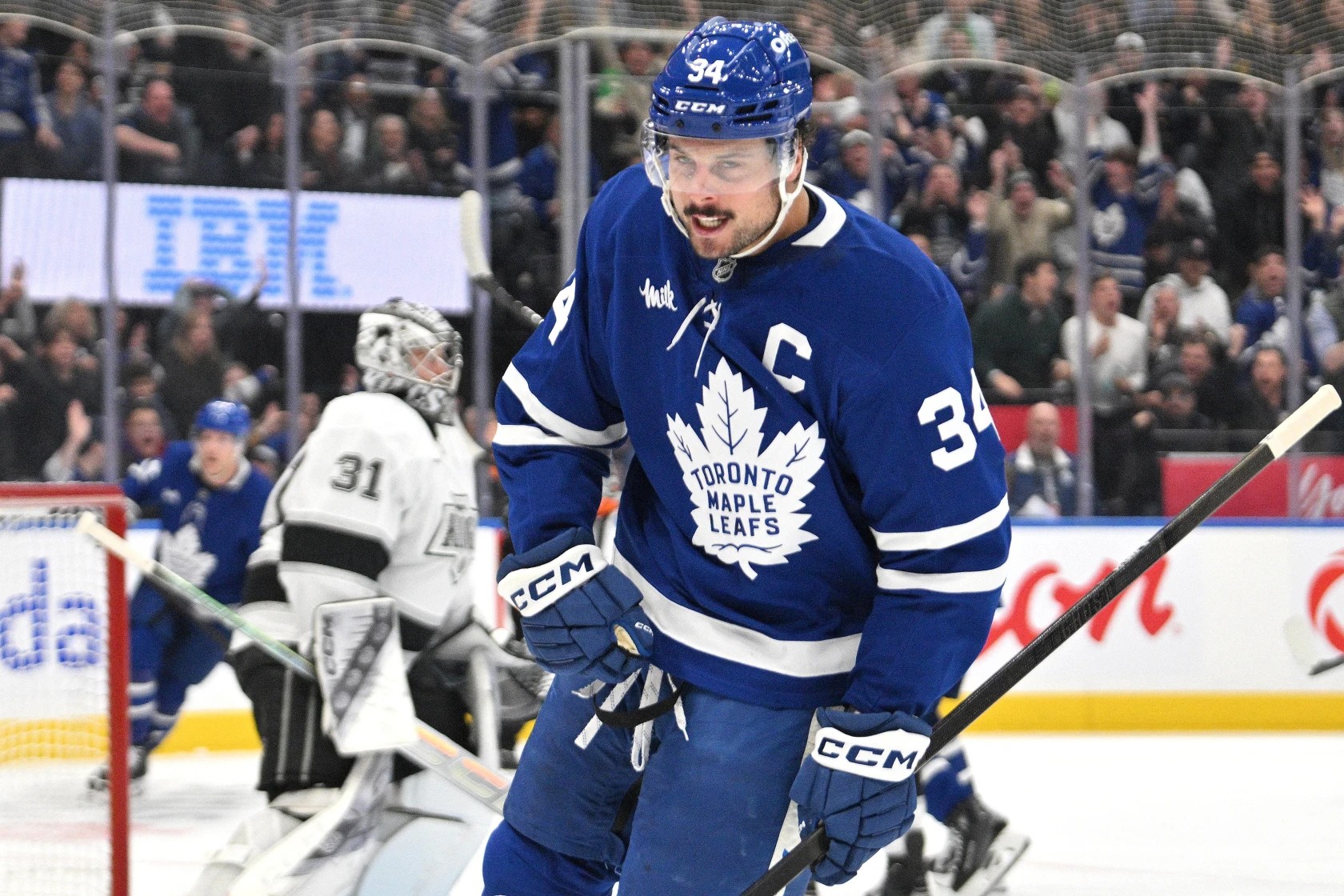When Auston Matthews was injured, there was a lot of talk about sticking by the John Tavares-Mitch Marner pairing when Matthews returned on account of the team’s strong record in his absence.
The Leafs‘ 7-2-0 record during Matthews’ injury made it easy to gloss over the fact that the team struggled to score at five-on-five, potting just nine five-on-five goals in that time, the worst mark in the league.
Goaltending aside, the Leafs rode a hot power play during Matthews’ time away. The Leafs had the second-best power play in the league in those nine games, clicking at a 32.4 percent success rate. Marner recorded nine power-play points during this span, only matched by Martin Necas league-wide, while Nylander racked up eight power-play points (everyone tied with Nylander played at least three more games). Even Morgan Rielly notched seven power-play points during this period.
Of all the things to learn from Matthews’ time off, this was perhaps the most critical, even if it’s counterintuitive: The power play was excellent without him. There might be something to it, and the Leafs appear to be thinking the same thing (as I’ll explain below).
When Matthews returned, he naturally walked right back onto the top power-play unit, which immediately went back to struggling, just as it had to start the season. In fact, after the Leafs‘ game on Thursday against Anaheim, the power play was 6-for-56 with Matthews in the lineup.
It’s an astonishingly lousy number, and if we extend it back to last season, it’s a continuation of what was happening from the point Marner fell injured in March of 2024. The Leafs’ power play clicked at just 10.3 percent in the 12 games Marner missed last March, and it was terrible in the playoffs. It was perhaps the number one reason several people lost their jobs after the season.
Now, this is not all on Auston Matthews by any means, but two critical issues are worth discussing and have generally revolved around him.
The Entries
The Leafs use the drop-pass slingshot play on their power-play entries, and they’ve generally deployed Matthews and Marner as the two drop-pass recipients.
You can understand the logic. It gives them a left-handed and right-handed player skating through the neutral zone with speed, able to play pitch and catch on their forehand. In practice, it didn’t play out effectively with enough consistency.
On the entries, the Leafs have their puck carrier (Matthews or Marner in this case) enter the zone with speed roughly through the faceoff circles. If/when the defender pulls toward them, they have a dump-off pass outlet they’re ready to chip it to on the half-wall, who will hopefully have the time and space to set it up (curl, pass it back to the defenseman, etc.).
In Matthews’ case, opposing PKs started sitting on the pass to the wall, and he didn’t make plays to cut in and make the other team pay for it. The Bruins cheated to the boards, but Matthews repeatedly passed it to a covered John Tavares for a turnover all series. More and more penalty kills started sitting on this entry play this season, and there wasn’t enough deception coming down the ice to pull the defender off the wall or take the available space.
Despite Marner and Nylander shooting the same way (right) — meaning, one has to catch a pass on his backhand through the neutral zone — they were really effective at entering the zone. Both players are more deceptive and will burn teams that cheat toward passing outlets.
On the goal below, David Savard took a step toward Matthew Knies on the wall, so Nylander cut back and made them pay:
Over the weekend, the Red Wings loaded the side Marner entered through, so he passed it across the grain to Nylander, leading to a goal:
Even with Matthews back in the lineup, he has benefited from Marner and Nylander handling the entries. Against Buffalo, Marner cut through the middle of the zone, sucked in defenders, and dished it off to Matthews, who walked in alone and ripped a shot off the crossbar.
With Marner or Nylander leading the charge, the entries are more creative and can make opposing PKs pay if they cheat.
The Half-Wall Play
It sounds weird to suggest the Leafs take the best goal scorer in the league off the half-wall on the power play, but if Matthews is not one-timing it from there, is he otherwise creating offense in this spot?
Matthews was sixth in the league in power-play goals last season, largely due to his one-timer, but his shot rates are way down for his standard — by over 10 per 60 on the power play compared to the last three seasons.
If he’s not letting it rip, not much else is happening. Even when Matthews collects assists in this spot, they are low-percentage plays such as the goal below against Minnesota, where he stood still and feathered a pass all the way through the Wild penalty kill for a one-timer goal. This is not something even Matthews can consistently execute successfully in the NHL.
When Matthews returned and the team ran five forwards on the man advantage, I was an advocate of the move. Everyone was in the right spot on the ice, but often where things broke down, besides the above-mentioned entries, was the half-wall play with Matthews.
Marner and Nylander are particularly effective — especially evident when the power play got hot — at moving around in the zone and creating passing/shooting lanes with their legs. Marner likes to catch the puck high and go “downhill” with it, such as in the example below against Boston. He caught it high, skated in, froze the defenders, and then bumped it high to a wide-open Rielly, who had all day to shoot.
Nylander has every trick in the bag. He’ll beat defenders with power moves, he has a bomb, he can move the puck, and if nothing is working, he’ll skate around and create options with his legs. Marner will do the same thing. That’s not really Matthews’ specialty, and the power play can become quite static as a result.
Over the past two games, the Leafs didn’t only put Rielly back on the top power play; they went back to the Nylander-Rielly-Marner trio up top as their base setup. They have scored power-play goals in both games since. Nylander and Marner have also been their primary drop-pass options in the two games.
While they lost Knies’ net-front presence, they gained an elite triggerman in Matthews. Their goal against Detroit is a good example of the benefits, as starting from behind the net, Marner skated around the zone and pulled up high across the top of the circle with the puck. Matthews read it and leaked out to the backside for a one-timer — an easy pass and goal for those two, but the goal happened because Marner skated and opened it up.
"AUSTON MATTHEWS TIES THE GAME!"
Matthews 10th of the Season vs Red Wings courtesy of @Bonsie1951 and @Jim_Ralph. @LeafsJelly pic.twitter.com/8Gt3q1J345
— Maple Leafs Hotstove (@LeafsNews) December 15, 2024
In the next game against Buffalo, Tavares scored the goal off a Matthews one-timer, but look at the build-up beforehand. Nylander took the puck behind the net all the way around to the other side and passed it up to Marner, who cut across the blue line with it. Nylander pulled high in the process, leading to a Matthews and Nylander passing sequence for a one-timer that ultimately deflected off Tavares and in. Again, the process is driven by Nylander and Marner’s movement.
TAVARES 13th vs Sabres courtesy of @Bonsie1951 and @Jim_Ralph. pic.twitter.com/7mgV41Snj0
— Maple Leafs Hotstove (@LeafsNews) December 15, 2024
This isn’t intended to rag on Matthews by any means. The Leafs need to look for opportunities to tee him up — this is obvious, and it earned them two goals over the weekend. But if they simply give Matthews the half-wall spot, he tends to become too static.
By comparison, Marner and Nylander have been consistently more dangerous in those positions. The Leafs appear to realize this, too, because it’s how they are setting it up right now.
When the team returned to its traditional four-forward unit with Rielly on defense, Matthews went to the net on their first power play. You can see it’s unnatural for him, and he’s not going to act as a traditional net-front player like Knies does (or JVR back in the day). But he can get lost in coverage from that spot and find space as a one-timer threat while Nylander and Marner dance around, attracting attention with the puck on their sticks.
It’s the same five players, but it’s a bit of a different look than we’ve seen over the past few years. We saw them succeed like this when Matthews was injured, and now they are attempting to integrate him into a setup that has given them their best run of power-play production in quite some time.
It’s a work in progress, but the Leafs must get this right. As we’ve seen in many playoff series over the past eight seasons, their post-season viability depends on it.
Programming note: This week’s Leafs Notebook, including the Notes, Quotes, Tweets of the Week, and 5 Things I Think I’d Do, is now available.
In the latest Leafs Notebook:
– A new third line to trial
– John Tavares' big first half
– Shot totals vs. zone time
– Can they keep the McCabe-Tanev pairing together despite Rielly-OEL's struggles?& much more via @APetrielli 👇 https://t.co/lbgVuum6fj #LeafsForever
— Maple Leafs Hotstove (@LeafsNews) December 17, 2024


































